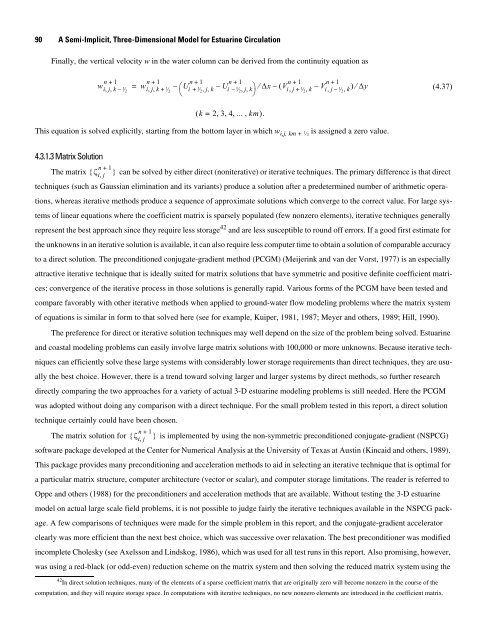A Semi-Implicit, Three-Dimensional Model for Estuarine ... - USGS
A Semi-Implicit, Three-Dimensional Model for Estuarine ... - USGS
A Semi-Implicit, Three-Dimensional Model for Estuarine ... - USGS
Create successful ePaper yourself
Turn your PDF publications into a flip-book with our unique Google optimized e-Paper software.
90 A <strong>Semi</strong>-<strong>Implicit</strong>, <strong>Three</strong>-<strong>Dimensional</strong> <strong>Model</strong> <strong>for</strong> <strong>Estuarine</strong> Circulation<br />
Finally, the vertical velocity w in the water column can be derived from the continuity equation as<br />
n + 1<br />
wi, j, k – 1⁄ 2<br />
=<br />
n + 1<br />
n + 1<br />
n + 1<br />
wi, j, k+ 1⁄ – ⎛U 2 i + 1⁄ 2,<br />
j, k–<br />
Ui – 1⁄ 2,<br />
jk , ⎞ ⁄ Δx – Vi j 1⁄ 2<br />
⎝ ⎠<br />
( k = 234... , , , , km).<br />
n + 1 n + 1<br />
( , + , k – , – ⁄ , k ) ⁄ Δy<br />
V i j 1 2<br />
This equation is solved explicitly, starting from the bottom layer in which w i,j, km + ½ is assigned a zero value.<br />
4.3.1.3 Matrix Solution<br />
n + 1<br />
The matrix { ζi, j } can be solved by either direct (noniterative) or iterative techniques. The primary difference is that direct<br />
techniques (such as Gaussian elimination and its variants) produce a solution after a predetermined number of arithmetic opera-<br />
tions, whereas iterative methods produce a sequence of approximate solutions which converge to the correct value. For large sys-<br />
tems of linear equations where the coefficient matrix is sparsely populated (few nonzero elements), iterative techniques generally<br />
represent the best approach since they require less storage 42 and are less susceptible to round off errors. If a good first estimate <strong>for</strong><br />
the unknowns in an iterative solution is available, it can also require less computer time to obtain a solution of comparable accuracy<br />
to a direct solution. The preconditioned conjugate-gradient method (PCGM) (Meijerink and van der Vorst, 1977) is an especially<br />
attractive iterative technique that is ideally suited <strong>for</strong> matrix solutions that have symmetric and positive definite coefficient matri-<br />
ces; convergence of the iterative process in those solutions is generally rapid. Various <strong>for</strong>ms of the PCGM have been tested and<br />
compare favorably with other iterative methods when applied to ground-water flow modeling problems where the matrix system<br />
of equations is similar in <strong>for</strong>m to that solved here (see <strong>for</strong> example, Kuiper, 1981, 1987; Meyer and others, 1989; Hill, 1990).<br />
The preference <strong>for</strong> direct or iterative solution techniques may well depend on the size of the problem being solved. <strong>Estuarine</strong><br />
and coastal modeling problems can easily involve large matrix solutions with 100,000 or more unknowns. Because iterative tech-<br />
niques can efficiently solve these large systems with considerably lower storage requirements than direct techniques, they are usu-<br />
ally the best choice. However, there is a trend toward solving larger and larger systems by direct methods, so further research<br />
directly comparing the two approaches <strong>for</strong> a variety of actual 3-D estuarine modeling problems is still needed. Here the PCGM<br />
was adopted without doing any comparison with a direct technique. For the small problem tested in this report, a direct solution<br />
technique certainly could have been chosen.<br />
n + 1<br />
The matrix solution <strong>for</strong> { ζi, j } is implemented by using the non-symmetric preconditioned conjugate-gradient (NSPCG)<br />
software package developed at the Center <strong>for</strong> Numerical Analysis at the University of Texas at Austin (Kincaid and others, 1989).<br />
This package provides many preconditioning and acceleration methods to aid in selecting an iterative technique that is optimal <strong>for</strong><br />
a particular matrix structure, computer architecture (vector or scalar), and computer storage limitations. The reader is referred to<br />
Oppe and others (1988) <strong>for</strong> the preconditioners and acceleration methods that are available. Without testing the 3-D estuarine<br />
model on actual large scale field problems, it is not possible to judge fairly the iterative techniques available in the NSPCG pack-<br />
age. A few comparisons of techniques were made <strong>for</strong> the simple problem in this report, and the conjugate-gradient accelerator<br />
clearly was more efficient than the next best choice, which was successive over relaxation. The best preconditioner was modified<br />
incomplete Cholesky (see Axelsson and Lindskog, 1986), which was used <strong>for</strong> all test runs in this report. Also promising, however,<br />
was using a red-black (or odd-even) reduction scheme on the matrix system and then solving the reduced matrix system using the<br />
42 In direct solution techniques, many of the elements of a sparse coefficient matrix that are originally zero will become nonzero in the course of the<br />
computation, and they will require storage space. In computations with iterative techniques, no new nonzero elements are introduced in the coefficient matrix.<br />
(4.37)

















